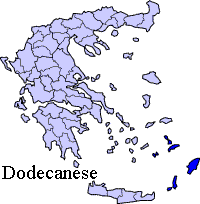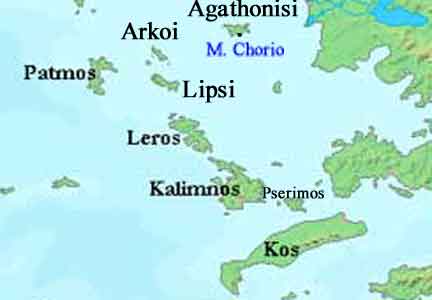|
|
Leros is a Greek island in the Dodecanese, in the southern Aegean Sea. Leros, the island of Artemis (Goddess of the hunt) is a beautiful, friendly island 171 nautical miles (317 km) from the mainland port city of Piraeus (45 min flight to Leros airport (IATA code: LRS), from Athens or 11 hour ferry ride from the port city of Pireaus); an island of 53 square kilometres having a coastline of 71 km. A member of the Dodecanese archipelagos, Leros, has a population of 8207 (2001) although this figure swells to over 15,000 during the summer peak. It is home to the fabulous Panagia Castle as well as two ancient fortifications.Very near to Leros is Patmos, Lipsi, Kalymnos and the small islands of Agia Kyriaki, Farmakos, Marathi island and Pigianousa. History According to Homer, Leros took part in the Trojan war (from 1193 – 1184 BC) under the leaders Antifos and Feidotos, grandchildren of Hercules. In Leros the sisters of Meleager were said to have been transformed into guinea-pigs (Meleagrids) (μελεαγρίδες). Thucydides stressed the special importance of the bays and the harbours of Leros during the period of the Peleponnesian War (431 – 404 B.C.), where Leros supported the democratic Athenians. After the end of the war Leros came under the sovreignty of the Spartans. It then followed the fate of the rest of the Dodecanese Islands during the years of Alexander the Great and his successors, the Roman years and the Byzantine period. On his campaign east, Alexander the Great passed through Leros as evidenced by the funerary steles and coins from that period found on the island. Constantine the Great, founder of Constantinople (Istanbul) and builder of the Byzantine Empire brought Leros into his empire by incorporating it into the Theme of Samos. In the year 1309 the Knights of St John of Rhodes seized and fortified Leros. In 1505 the Ottoman Admiral Kemal Reis along with three galleys and other seventeen war sailing vessels besieged the castle but could not seize it. The operation was repeated in 1508 with more ships but again nothing was achieved. On the 24th December 1522 a treaty was signed between the Sultan Suleiman and the Grand Magister of the Knights Adam Villers de Ille, and Leros was passed into Ottoman hands. During the Ottoman occupation Leros, along with the other islands, enjoyed a regime of privilege with partial autonomy and self–government. During the Greek revolution of 1821, the island became an important base for the re-supplying of the Greek Navy. After the struggle for revolution the island became a part of the free parts of Greece and it came under the jurisdiction of the Temporary Committee of the Eastern Sporades. With the Treaty of London on the 3rd February 1830 which determined the borders of the newly – established Greek state, the Dodecanese were given over to Turkey again. In the “Diary of the Prefecture of the Archipelagos“ of 1886, Leros along with the islands of Patmos, Lipsoi and Fournoi belonged to the Turks. The administrative council was made up of both Greeks and Turks. The Italian Period From 1911 to 1912 the Italians occupied all of the Dodecanese islands. In 1912 the island was seized by the Italian battleship “San Giorgio” during the war between Italy and Turkey. Under the watchful eye of Mussolini, a new town, Portolago, was created in the 1930s, with its now infamous Italian Rationalist art-deco architecture and streets wide enough for military parading. The Greeks later renamed it Lakki. The Italians tried to "Italianise" the island and the inhabitants responded by declaring the autonomy of the islands under the title “The Aegean State”, with the aim of reunification with Greece. During the 35 years that the Italians remained in Leros, the Italians set up a great plan to build and fortify the island, as a result of considering both its strategic position and its physical form with its large natural harbours, the largest of which, Lakki, is the largest deep water harbour in the Mediterranean Sea. The fortification of Leros and the creation of a major naval base at Lakki, ensured that the Italians had control over an area of vital interest to the Allies (the Aegean, the Dardanelles and the Near East). Mussolini saw Leros as a crucial base for Italian domination of the eastern Aegean, even building a mansion for himself in the town of Portolago (now Lakki). Some of the important Italian architects were Rodolfo Petracco and Armando Bernabiti responsible also for other buildings in the Dodecanese during the period when it was ruled by Italians.
Leros Panteli World War Two In 1940 as Italy was on the side of Germany, Leros suffered attacks and bombing by the British Royal Air Force. As a result of the naturally protected coves and the protection they provided to warships, the island was the second most bombed during World War Two (after Crete). On the 8th September 1943 as Italy could not continue the war on the German side, it signed an armistice and came over to the Allied camp. After the Italian armistice, British reinforcements arrived on Leros and the island suffered continuous German bombing. One of the largest attacks was on the Greek Navy's Flagship, the Queen Olga, sunk by German bombers on Sunday September 26, 1943. The British Royal Navy ship, HMS Intrepid, was also sunk on that day in Portolago. Modern History On the 7th march 1948, Leros as with all the Dodecanese, was reunited with the rest of Greece. After approximately 400 years the Dodecanese became officially Greek once more. During the post-war years the Greek governments used many buildings in Leros for various reasons. In 1959 the mental hospital of Leros was founded, whose original primitive conditions have been improved to such an extent that today it is considered a model for the reformation of psychiatric care in the whole of Greece. Tourist Highlights Leros has a number of charming small towns and beaches.
Leros, Port of Agia Marina Agia Marina has a number of bars, nightclubs and restaurants, all located in a strip which overlooks Alinda Bay. They include Meltemi Bar, Apothiki (Warehouse) Nightclub, Music House and the 24 hour cafe/restaurant, Glaros (The Seagull). Further down the road in Mproutsi you will find the famous Faros Bar, a bar built into a cave underneath the old lighthouse. The bar has an outdoor area which has a platform on the water, overlooking the entry to Alinda Bay and a breakwater.
Platanos, Castke of (Kastro Panagias) on the Hill Apitiki Pandeli is also a well known area, littered with wonderful restaurants which are perched right on the water's edge. At one end of Pandeli Bay sits the famous Savana Bar, run by two Englishmen, Peter and Simon. The bar is well known for its Scandinavian barflys, "Aussie" breakfasts and multitudes of tourists who take advantage of the bar's location next to the pier after they moor their yachts in the harbour during a Leros stopover. Travel Information Leros has an Airport at Partheni that connects daily the island with Athens. There are also ferry connections to and from Athens and the other islands of the Dodecanese. The Catamaran Dodekanissos Express (all year) and the Hydrofoils (only during the summer) connecting Leros with the most of the Dodecanese islands. For those who want to visit Leros the alternative way to Ferry travel (8-10 hours) is to fly to Athens and then fly to Leros with domestic flight or fly direct to Kos and then to Leros by boat (1 - 2 hours). Division of the municipality of Leros
Persons See also Agia Kyriaki island Vassilis Colonas, Italian Architecture in the Dodecanese Islands (1912 1943), Athènes, OLIKOS Press, 2002; Links Retrieved from "http://en.wikipedia.org" A - B - C - D - E - F - G - H - I - J - K - L - M N - O - P - Q - R - S - T - U - V - W - X - Y - Z
 |
|
|||||||||||||||








